Share
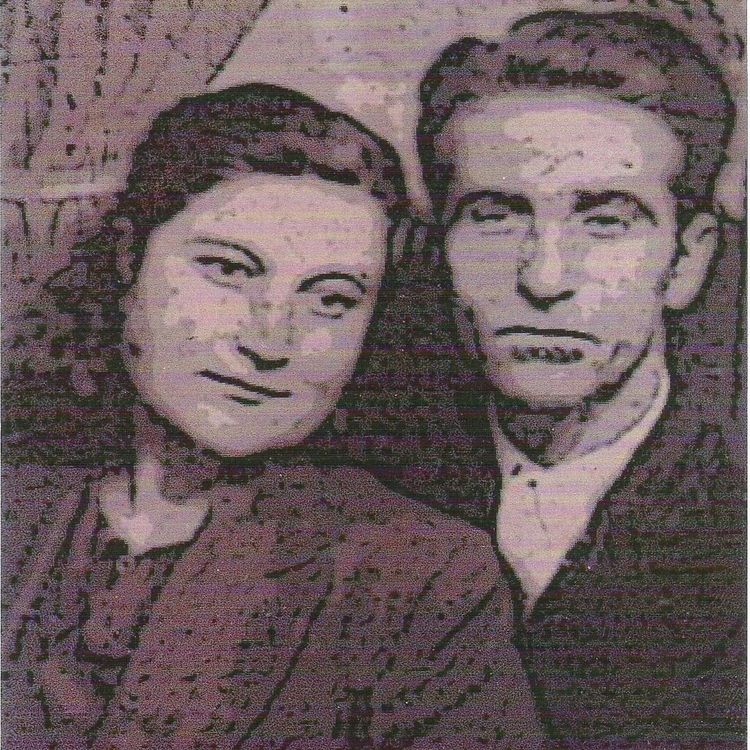
The Delicious Legacy
Grandma Ntinas Food Memories
Back in 2009 I had the idea to record some of my grandmother's old stories. For posterity reasons, but mainly for me to document some of the so many different stories that she used to tell us since we were kids, and over the years, during the family gatherings, be it Christmas, Easter or other holidays and celebrations. She was a natural story teller, and she was from an interesting family that lived during interesting times. ( to say the least!) Her name was Evangelia Ntina (taking the surname of my pappous {grandfather}) her family name was "Karali" -I should spell it Kar-a-lee perhaps to make sense phonetically? Ntinas by the way is pronounced "Deenas" as the letters N+T make the sound D in the Greek language.
Anyway, she told us so many stories over the years; of course some of her opinions in actual historical facts contradicted what I was aware as real history, or even her stories were often confusing. I needed to have a definite record of her own words and her own world, even if it wasn't exactly absolute and real, at least it was her own reality! In any case having everything documented, forever, would have meant I 'd have the opportunity to examine her stories at a later date, share them with my uncles, aunties and cousins, and keep some family history alive, and not lost in the midst of time, and in the mouths and words of different people with different agendas!
So when I had the opportunity for a short visit back home in Greece and my home town of Veria, I brought my laptop, an audio interface and a microphone with me from my studio in London and off I went to my grandmother's house! She was at that time nearly 85, so time was of the essence, I didn't know how many opportunities I'd had later on, and what would her mind be in the future, for her to give me her stories as she remembered them. And it was lucky that I did this when I did, as she sadly passed away in 2013, and the last couple of years of her life she was mostly bedridden.
The whole aural documentary with my grandmother lasted about 4 hours, and I edited several bits to their own individual stories, one about her parents and grandparents, one about the second world war and civil war that followed and of course one about the diet, the foods, the cooking and eating back in the frugal pastoral daily lives of families in the mountainous central north west Greece somewhere between the prefectures of Grevena, Kozani and Trikala...
So a bit of a context here: My grandma's father (from my dad's side) so my great-grandfather -which I met many times in the first 8 years of my life- was born in 1893, in what was back then the Ottoman Empire. His name was Dimitris Karalis. He subsequently became a teacher at a very young age in the local school, of the small villages in the area, age 16 (!!!), and then, later on, a priest. They lived in a village called Katakali, with the extended family his brothers and sisters and led a pastoral life mainly with sheep, pigs and some cattle, and of course cultivating the land too. No electricity, no petrol powered vehicles just donkeys, bandits roaming the mountains kidnapping people for ransom and so on...The area became part of Greece after the Balkan Wars in 1913. But, life for the peasants, the poor and the farmers didn't change significantly, nor the day to day toil...My grandmother had in total 8 siblings, some of whom died in childhood of course. As I was growing up I think I met 4 or 5 who survived to an old age.
So to our story:
...And what did you eat in the big Lent periods of the year? Easter and Christmas grandma?
We didn't eat oil , only on Saturdays and Sundays. In the winter we did not have vegetables such as peppers and aubergines that we have now. If we had pickled veg, like cabbage and peppers and so on, would eat these veg straight out of the jar, or we would fry them for a more tasty and salty snack. But mainly cabbages, endives, and leeks, with some wild poppies if the weather was good, which we would find growing in the fields... Chickpeas, peas and beans alongside with lentils that we used to grow, some yellow peas, and some other types of legumes ( called them "fakos" which I can't really decipher what she meant by this) we had a decent size croft/allotment around 500 square metres and we would sow one line with one type of legume, one line of another one and so on...we would not eat olive oil for the whole Lenten period... (alongside with any animal fat)
-What type of oils did you use, that were common back then? Did you have olive oil?
ah of course we had and used olive oil, we had always olive oil coming from south, Kalamata, Crete and so on...No bottles of course, glass bottles weren't common back then, but big tins, 16 okka in weight (this was an ottoman measurement equivalent to 400 dirhems per okka which was used by grandmothers well after WWII) This means that the 16 okka tin weights 20 litres today! A considerable size tin then, and one that had to feed a family of 7-8 for the whole year
For the Christmas lent, we were eating fish a lot, as this was allowed. (it is not as strict lent as the 'Big Lent'; the Easter lent, which we used to only eat fish on two occasions, two big Christian celebrations that would fall in the early spring pre-Easter Sunday. This is Palm Sunday, and Annunciation of the Virgin) but of course back then especially in the mountain villages that my ancestors inhabited would have much fish to eat.
Did you had rivers and did you eat sweet water fishes up there back then?
"We had some small fish, from creeks and streams, but the main big river Aliakmonas was a little further away and the people back then they would throw a dynamite piece or some short of hand grenades (!!!) the fish would be stunned and they would be able to gather many with ease. One year my young brother Lambros went there to get fishes and it brought some big fishes with him which we roasted in a huge round oven dish the big ones we used to make pies in it. My mother would ask "where did you find these massive fishes then?" and Lambros answer was "we gathered them in Aliakmonas river"! It transpired though there was a family friend from a village near there, a hunter of rabbits, who had lost one hand from a previous dangerous fishing activity; He had thrown some explosive of sorts into the river and the boys went and gathered the fishes afterwards! From the shore of course, from the riverbank, whatever was coming towards them! The hunter used to bring some rabbits to our father (My great-grandfather the village priest) occasionally as a present.
Our father used to bring us some small fry from the local rivulet or streams. Small but sweet fishes!
Did you used to make pies?
Yeah of course lots cabbage pies, cheese pies, with corn and cheese and pork fat/lard and "koolouropites" aka pies with milk eggs and butter and flour of course.
We used to slaughter 100 okka pork and has 2-3 tins of fat and used it to cook with it over the summer. It was great to use, and tasty, and kept well, and preserved, as it was salted and when it was rendering in the pot over the fire... at the end when was nearly ready we also used to add a chopped onion, the onion was absorbing all the foul smells and thus it was good to use all summer long!
...Now we are afraid to eat lard ...I have a tin of it in the fridge...
-Why?
she laughs...
Until a few years ago i used to put some in the pies...it was good!
-How do you make the lard then?
Look the pork meat is separated in two parts one white fat and one red the meat. the white would be separated and made in big cubes and in a pot with some salt over the fire and let it there to boil for hours until it became a golden liquid i'll saw you i'll bring you some your dad brought some here last year, look and try and smell it doesn't smell at all...!
-And why you are not using it anymore?
i have gall stones and getting older and all..
{Sniffing the jar with the home made, well preserved lard}
-Yeah it doesn't smell at all.
if you take a kilo of olive oil and a kilo of this homemade lard will be in a similar texture and manner of the readymade spreads you get nowadays from the supermarkets and it's so fluffy and light in texture it feels like a feather! It's good ...Haven't used this unfortunately.(she laughs)
-But the pure one you talking about rendered with salt and onion, it keeps and it doesn't go off as you say, for a year right? Then but know we have fridges...
yeah of course.
now with the fridges you can keep it there and it would be ok for longer. just add a little bit of that in the pies and the taste will be explosive!
she laughs
instead of using spreads and margarine type...
like this...people would find a way to preserve and eat everything from the animal.
In the big can of this fat, we would cook big pieces of meat would be inside this fat and were kept in there throughout the winter months and during the summer time after a day in the fields would pick some and eat to give us a boost and stop the hunger. as we didn't have fridges the houses had a larder, usually cold, dark and dumb, generally underground, especially in not so warm summers, with no windows and thick stone walls, fat in these tins of preserved meat was still solid! we would take out as i said 2-3 big pieces of meat out, we were also adding salt, coarse salt, and we would cook it with wild greens and other summer greens...or make a batter or a mush with flour...
Do you remember Filimon and Vavkida a myth from ancient greece.... Baucis and Philemon were an old married couple in the region of Tyana, in Phrygia, and the only ones in their town to welcome disguised gods Zeus and Hermes ), thus embodying the pious exercise of hospitality, the ritualized guest-friendship termed Xenia, or theoxenia when a god was involved.
The old married couple were supposedly served them some smoked meat with bitter greens as this was the only food they had and whenever i used to eat this dish as a girl i always remembered this story...for years now i couldn't remember the names of the couple and now that i'm telling you the story their names finally felled into my lips!
-And how do you make 'koolouropita' yiayia? what is it?
you make dough, classic fylo, wet it with a bit of fat and spread crumbled feta, you could add beaten egg but without is good and then you make it in a spiral in the round oven dish. My mother used a massive round pie baking dish and didn't made the pie as one big spiral but rather individual loooong sticks and we used to grab one each and eat it greedily...!
laughs....
usually they would make it with corn flour with a very fine sieve and and it was so so fine! and used this (she then goes on about some flour sieving techniques and number of pies which i have no clue how to translate )
In essence there was a technique of making big quantities of fylo and have it ready made in the house to use when you need to make a pie and not make (or 'open' as is the grandma terminology in greek) every time from scratch ...it seems they were cooked over a griddle...then they used to 'wet' them with a little water and cheese and melted fat and some wild greens if they had and were cooking it like this. and made pies likes this!
-I remember you used to make nettle pie hey?
I did and still do, i did this year as well. i have some in the freezer ready to use. although your aunties had a rummage in the larder and shuffled and jumbled up my system!
-What do you do with the nettles before you freeze them? How cook them?
I steam or boil them till soft and tender, usually the stems of the nettles are tough and need some time to boil. one day we didn't notice how hard the stem was , from an old big plant and it wouldn't cook!
We do put some leeks and some spinach as well. and we make the pies with this mix, alongside with some crumbled feta and becomes toothsome and very appetizing. Your aunty Soula made it big and fat as we were many and we only had one piece of the pie each so the filling was very generous and thick thick pieces!
If you eat it greedily, fast and while it's hot straight from the oven then it's not really good for the stomach, but you can't really help yourself!
-How do you make your fylo for the pie?
We make little 8 dough balls for the bottom of the pie . around 6-7 for the top of the pie. we spread with butter on every fylo then we layer each one of the 8 balls. On top we brush the last fylo with a bit of oil too. That's how we did it. stuffing either nettles or wild greens
I used to have nettles in the back garden back in the day and i used to prune them regularly and this made the soft and tender for the pies.
-When you say "tsouknidia" you mean the actual nettles that sting right? how di you collect them?
By hand as usual. they are the normal stinging nettles, it was a little painful, my mother used to collect them with the newspaper, and she was squeezing them inside them newspaper till the stems and leaves were crushed and wouldn't sting anymore.
In the time of the great hunger in 1941-42, we had a family from Deskati (a village in the cluster of villages in the area that my grandmother used to live with her family) their father was a craftsman but during the war and the Nazi occupation of course there wasn't any work. as with many others they were starving. we would see the poor kids were going under the bridge in the local stream, were a lot of nettles would grow, and they were cutting the stems of the nettles, simply crushing them between two rocks with some salt and would eat just this. Sometimes thankfully the local farmers would always something little to give them even it was a bit of flour to make some bread, and this is how they survived .
-In the war, nettles and snails imagine was probably all you ate right?
We didn't eat many snails to be honest, but we weren't used to them and didn't eat them to be honest.
The refugees used to eat them after the rains used to collect them. (the Greeks from Minor Asia after the 1922 pogroms) they were cleaning them by putting them in oats so they were cleansed and they were sauteeing them with wild greens
In the old days the locals in the area used to collect them and sell them in the local markets.
Your father and his siblings didn't use to eat the snails, i was collecting them every day from the garden patch and cooking them, but everyone was refusing to touch them. I was collecting them and I was eating them by myself! The kids would even get near to them!
(then talks about how to cleanse the snails from their slime)
My little girls (her daughters, my aunties) used to be friends with the girls from a lady from my village and they used to put the snails on the hot ashes and cooked them this way...Your aunty Tasoula sometimes keeps telling these stories...
/END
I hope you enjoyed this regardless of the fact that is in Greek -and old grandma Greek for that matter- and for the Greek speakers amongst you, if you think I've missed something interesting from my grandmothers story do let me know and I will add it!
Thanks!
Support the podcast on Ko-Fi and Patreon for ad-free episodes!
More episodes
View all episodes
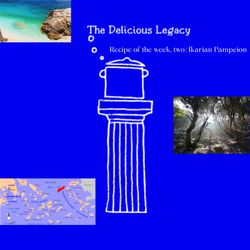
Stocking fillers: Recipe of the week, two: Ikarian Pampeion
06:51|Hello!Every Saturday in The Delicious Legacy podcast your freshest "stocking filler" recipe of the week is out!This time I’m travelling to the delightful island of Ikaria in the Western Aegean sea!With a simple one pot veg recipe!If you want to know more about Ikaria, read my Patreon post here:https://www.patreon.com/posts/ikaria-island-of-115744979Music by Milts BoumisLove,The Delicious Legacy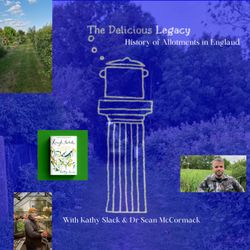
20. A History of Allotments in England
47:08||Season 7, Ep. 20Hello!New episode is out now for you my delightful Patreon backers! Out early and ad-free!Why England and by extension all of UK is so allotment "obsessed" ? What does it all mean?Firstly, what is an allotment? When did it all started?As someone who moved in UK many years ago, seeing this lovely spaces in cities filled me with a sense of serenity, and an air of quaint old school happiness lets say, they evoked something romantic and from long lost era. Of course over the years I learned a lot about why these exist; what purpose and role fulfil in the society and the soul of the nation.Who has one, who are they owned and maintained by, and crucially why people still insist having? What is the source of their popularity?Importantly, can one person/family feed themselves with produce from an allotment? Is there any point on doing so?Anyway I hope you'll enjoy my little potted allotment history here alongside with the interview with author and gardener Kathy Slack and nature conservationist, environmentalist and wildlife presenter Dr Sean McCormack!Kathy's Substack and Insta:https://kathyslack.substack.com/https://www.instagram.com/gluts_gluttony/Sean's media:https://drseanmccormack.com/https://www.instagram.com/thatvetsean/Get his lovely children's book about rewildinghttps://www.thegreatbritishbookshop.co.uk/products/beaver-believerspos=1&sid=f9e160ecd&_ss=rLinks about allotments and London's city farms and gardens:Calthorpe Community Garden:https://www.calthorpecommunitygarden.org.uk/about-usSitopia Farmhttps://sitopiafarm.com/pages/about-our-farmCommunity veg boxes:https://growingcommunities.org/Love,The Delicious Legacy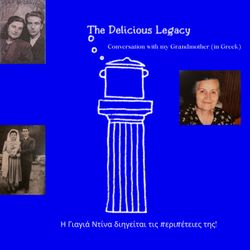
19. Conversation in Greek with my Grandmother - Η Γιαγιά Ντίνα διηγείται τις περιπέτειες της!
45:28||Season 7, Ep. 19Hello!This is another episode in Greek, my little parallel series of getting some episodes out for Greek audienceThis time I thought I'll release a part of my conversation with my grandmother- my yiayia- my father's mother.From the mountainous north west Greece, her childhood up in the villages, where bandits and others where making life hard in the 1920's. Only a few years earlier this part of Greece was part of the Ottoman Empire.A fascinating story of a troubled period for Greece, her story takes us from the 1920's to the end of WW2.I recorded this about 17 years ago! It was 2009. EnjoyThom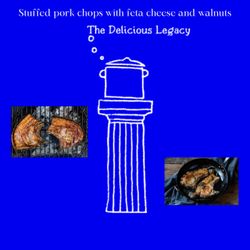
Stocking fillers: Recipe of the week - Stuffed pork chops with feta cheese and walnuts
05:02|Hello!Your recipe of the week is here!Every Saturday in The Delicious Legacy podcastEnjoy!Thom
18. Traditional Christmas around the Greek Table
26:40||Season 7, Ep. 18Hello! Christmas is approaching! Time for some recipes to inspire you in your Christmas cooking! (If you do cook of course! Otherwise, psssss, pass it on to your spouse!) It's also the time the ‘Kalikanzaroi’ (goblins that live underground all year according to Greek folklore) are coming up to Earth to annoy humans. How do you distract them? What foods do they like? So I've got a little treat for you, my curious and greedy gastronomers! On this episode of The Delicious Legacy podcast, we are going to Greece, so aside from melomakarona, stuffed chicken with rice and chestnuts, or roast piglet, what else do we Greeks ate at Christmas past? What was on the festive table in Epirus, Crete, Mani, Thrace, or even Kastelorizo? Let's re-discover some of the older, regional, and nearly extinct dishes for all corners of the Hellenic world! What is "Patoudo"? What about the dish called 'baby Jesus's "swaddling clothes"? And "babo"? What is the dish called "Gold" from the remotest Greek island to the East? These and much more on today's episode!Listen now -on all platforms that you get your podcasts from- and share with friends, family, colleagues, and rate and review! Enjoy! x The Delicious Legacy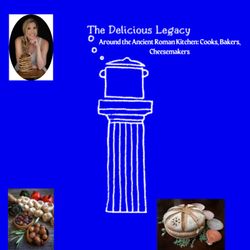
17. RE-AIR: Ancient Rome's Bakers, Cooks and Kitchens w/ Extra Content!
53:24||Season 7, Ep. 17Hello!On this classic episode from the archives of The Delicious Legacy I decided to include some ten minute of extra content from my interview with Farrell and I have remastered the audio as it was a bit dodgy the last time round. Hope it's more pleasant and easier to listen now!I'm very excited about this episode! Farrell Monaco is a culinary & experimental archaeologist, and bread-baking addict! Especially of the ancient Greco-Roman variety...So what better person to chat about the ancient cuisine? And it's a very thought-provoking and thoughtful. Who were the people (and the animals!) who did the hard work?Currently in California -where she was when we spoke online- but mostly researching in Pompeii, Herculaneum and Ostia about ancient Greco-Roman breadways.More info on bread from Pompeii by Farrell Monaco:https://www.bbc.com/travel/article/20230629-adoreum-the-newly-discovered-flatbread-fresco-of-pompeiihttps://www.bbc.com/travel/article/20230406-arculata-the-bread-that-survived-pompeiiApuleius and The Golden Ass:https://en.wikipedia.org/wiki/The_Golden_AssEtruscan Tarquinian Tombs:https://tarquiniaturismo.com/tomb-of-the-triclinium/?lang=en Farrell's website and blog:https://tavolamediterranea.com/Music by Pavlos KapralosEnjoy!Thom & The Delicious Legacy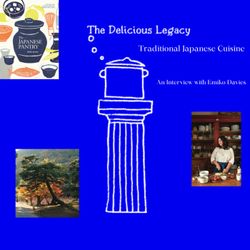
16. Traditional Japanese Cuisine
55:27||Season 7, Ep. 16Hello! New episode is out and I couldn’t be more excited about it!I've interviewed cookbook author Emiko Davies about her latest book "The Japanese Pantry" which came out in October this year.Emiko shares stories of her travels off the beaten track to meet the makers and pay homage to ancient traditions that have been around for centuries. Ingredients, dishes and recipes that are lost in the mists of time, and rare foods that might be lost forever!How do you make sake and rice vinegar? What are the sake lees and how do we use it? What is the rare delicacy of Yubeshi?We will explore the key ingredients of Japanese cuisine and on top of this, we will take a deep dive some unknown ingredients and dishes from all over the Japanese archipelago.You can follow the pensioner, mountain tea farmers who farmed at 1000 feet above sea level deep inside a forest, on Instagram at @nakaichamuraiEnjoy!Thom & The Delicious Legacy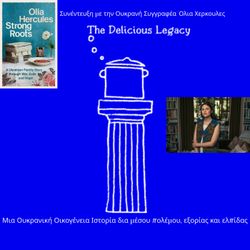
15. More Conversations In Greek - Συνέντευξη με την Ουκρανή Συγγραφέα 'Ολια Χερκουλες
55:30||Season 7, Ep. 15Hello!This episode is in Greek and it's the translation of the episode I recorded a couple of months ago with the food writer Olia Hercules about Ukrainian Food and Culture! The original episode can be found here: https://shows.acast.com/the-delicious-legacy/episodes/ukrainian-food-culture-with-olia-herculesΓεια σας! Το σημερινό επεισόδιο είναι μια συνέντευξη με την Ουκρανη συγγραφέα και σεφ Ολια Χερκουλες, που θα μας πει για την παραδοσιακή κουζίνα της Ουκρανίας, και τα φαγητά αλλά και τιε επιρροές από τους γείτονες λαούς μέσα στον χρόνο.Μιλήσαμε επί της ευκαιρίας του καινούργιου της βιβλίου, με τίτλο Strong Roots: "Μια Ουκρανική Οικογένεια Ιστορία δια μέσου πολέμου, εξορίας και ελπίδας"Μπορείτε να βρείτε αυτό αλλά και όλα τα βιβλία της εδώ: https://oliahercules.com/booksΕυχαριστώ για την ακρόαση. Μέχρι την επόμενη φορά, ας είμαστε δυνατοί γεροί και γεμάτη κουράγιο και ελπίδα.Η μουσική είναι του Παύλου ΚαπράλουΜε εκτίμηση,The Delicious LegacyThom Ntinas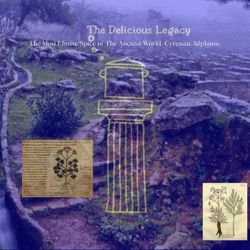
14. The Most Elusive Spice of The Ancient World: Cyrenaic Silphium
44:12||Season 7, Ep. 14Hello!A newly updated episode about Silphium! Or Asafoeitida? I was inspired by History Hit's newly released documentary with Dan Snow called Ancient Adventures: Libya where the team went to explore extraordinary Greek and Roman sites, centred around one of the greatest cities of the ancient world, Cyrene.So I thought it is time to talk again with more updates about silphium and with recipes and tasting by me here!What do we know of the ancient silphium? What do the authors say it tastes? And when was the last time that it was mentioned in texts?Plus the relationship with it's eastern cousin asafoetida and its use in Indian cuisine!Enjoy!With the voice over by Mark Knightand music by Pavlos KapralosLove,Thom & The Delicious Legacy